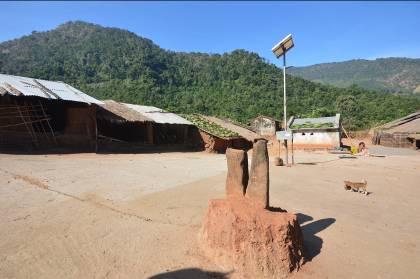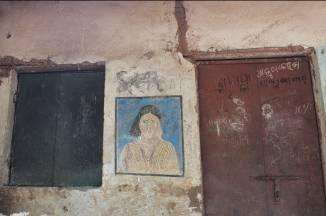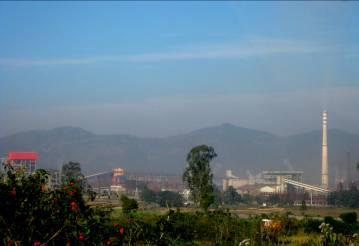While the mainstream narrative in India is wallowing in euphoria over an era of growth and development ushered in through increasing production and consumption, in remote pockets of the same country, people have continued to live amidst natural wealth, unimpressed by and unconverted to this massive frenzy for “more”.
In December 2014, we visited one such group, the Dongria Kondh tribal community of the Niyamgiri hills of Odisha. This community was catapulted to fame by their rejection of mining and consequent plans for industrialisation imposed by the state in cohorts with a corporate giant, a plan which threatened to destroy their habitats.
But the reasons for what led this community to fight for their land -- their respect for and strong sense of belonging for a way of life -- run much deeper than just an unexplained fear of development and an alien culture. To understand that, it is essential to know more about what they have got from their experience of ‘development’ so far.
The people of the mountain of law
The entire Niyamgiri range and its foothills and plains are part of an important biodiverse landscape, and the only home of the Dongria Kondhs. The plains host the Kutia Kondh community and settled scheduled caste communities who have long been part of the Niyamgiri landscape and have developed a close association with the forests and the fertile soil of the foothills.
Twin stones erected at the centre of Serkapadi village square, invoking Niyamraja. Pic : Ashish Kothari
The Dongria Kondh identify themselves as Jharnia, the protectors of the numerous streams of the Niyamgiri hills. Dongria, the people of the mountains, is the name with which the ‘other’ world associates them. As we travelled across villages in the Niyamgiri range, almost every Dongria Kondh elder reiterated that everything within their world belonged to Niyamraja. Niyamraja is everything.
Thus Niyamraja, that would literally translate into the King of Law, is the supreme deity of the people as well as the ancestral spirit; the people are his descendants. The Niyamgiri hills are “the hills of law,” the abode of Niyamraja, who rules the hills along with other deities closely associated with nature. The law as prescribed by Niyamraja disallows unsustainable exploitation of the forests and the land at the behest of greed.
The Gandhian economist, late KC Kumarappa in his book The Economy of Permanence gives us an insight into the emergence and sustenance of this way of life. He pointed out that nature is “unforgiving” and “ruthless” and if we are to look at our “self-interest” and “self-preservation,” it demands complete non-violence, cooperation with and submission to the ways of nature.
In this part of the country, as in almost all tribal tracts, land, livelihood, society and culture have so far remained intricately linked to and inseparable from nature. Through the laws prescribed by Niyamraja , the Niyamgiri hills have thus been nurtured for centuries by the Dongria Kondh.
The modern state and its inroads
The modern state, however, has been constantly at odds with the way of life of these communities, always emphasising their ‘mainstreaming’, either through patronising and ill-conceived welfare schemes, or by colonising and forcefully acquiring their lands, territories and resources. Both these contradictory state arms work in tandem as they seek to lay the foundations of the current economic growth and homogenous globalisation model.
Both the Dongria Kondh and Kutia Kondh have been classified as ‘Particularly Vulnerable’ by Indian policies, classifying them as a people with a stagnant population, low levels of literacy, pre-agricultural levels of technology and subsistence economy. This label has only helped to highlight what is seen as backwardness and the communities are often looked upon as needing assistance to uplift them from their primitiveness.
In 1964, the Dongria Kondh Development Agency (DKDA) was set up to launch such developmental programmes in Niyamgiri. This is still operational, covered under the Tribal Sub-Plan funds. The DKDA website proudly showcases that it has helped to establish pre-primary and primary schools, road networks and tubewells, while “enhancing” the agricultural output by encouraging tribals to grow more horticultural crops.

The school building at Gorota village now being used as a storehouse. Pic: Ashish Kothari and Rashi Mishra
However, the picture in the villages we visited presented a stark contrast to the DKDA claims. The school building we saw at Gorota was being used as a storage space. The elders said that the education system alienates them since lessons are taught not in the native Kui dialect but in a language (Odiya) that barely anyone uses. The curriculum, too, features nothing of the local history or culture, and is taught only by outsiders rather than village elders.
Bari Pidikaka, a Dongria Kondh elder, showed us an old scar on his leg marking the spot where he had accidentally cut himself with his axe. A traditional healer, he cured the deep wound himself, with herbs from the forests. The use of government hospitals is still rare, as they prefer medicines prepared from herbs and plants found in the hills.
Even roads, touted as a developmental milestone in the mainstream narrative, are seen by the local people as unnecessary and even harmful to their culture. When we asked Lado Sikaka, another Dongria Kondh elder, if more roads would help the community, he said, “We don’t want roads. We don’t have any vehicles. If a road is made, who would it be made for? People from outside will come and destroy this place if roads are made. We never lock our doors, our women and girls move about safely. People coming from outside will put an end to that way of life. Criminality and theft will take roots and all this will lead to insecurity. People here might get influenced and copy their (outsiders’) exploitative system.”
Economic exploitation
The role that the monetary economy comes to play with increasing development has also increased the challenges of existence for the tribal people.
The Dongria Kondhs explained that their need for money some years ago was only for a few essentials like clothes, salt, oil, marriage expenses and for celebrating some community festivals. They acknowledged that the dependence on money has increased over the years, largely owing to the inflated prices of cloth and other commodities.

Bride price has also gone up and the poorer Dongria Kondh are finding it difficult to keep up with it. In some villages, young men have migrated in search of jobs to keep up with the increased need for money while in others, there has been an increase in cultivation of cash crops and horticultural produce. The influence of external cultures and ‘modern’ living is increasingly alluring the youth. There is an increased indulgence in liquor, supplied by outsiders.
The increasing need for money also leads a host of Dongria women and men to carry wood for sale every morning to Muniguda, thereby increasing deforestation. Elders complain of streams having dried up.
The easy access to certain rationed goods like rice through the Public Distribution System has changed the food habits of the people. When asked if they need the rice, most said they take it only because it is being distributed.
Schemes such as the Indira Awas Yojna have seen asbestos roofs creeping into the Dongria villages instead of the traditional thatch roof structures. The new roofs trap heat in the house, making it hot and stuffy, say the people of the villages.
However, in what is perhaps a positive sign, the Dongria Kondhs have begun to perceive these threats and the need to combat them. In the local meetings of the Niyamgiri Suraksha Samiti, they have begun addressing these issues. While we were in Niyamgiri, there were a series of anti-liquor meetings in the Dongria Kondh villages. In these meetings, several aspects of the loss of cultural values, the need to revive and stay true to their culture and the need to protect forests were stressed upon by the community, elders and youth alike.
Mining and its impact
While on the one hand, the government continues to administer these top-down, mismanaged developmental schemes, on the other, the state has tried to assist corporations in extracting bauxite from these mountains to feed its growth fetish. For more than a decade now, the Niyamgiri hills have been the stage of an epic battle.
A Memorandum of Understanding (MoU) between the State of Odisha and Sterlite Industries (now Sesa Sterlite, the Indian arm of the global mining behemoth Vedanta Corporation) attempted to seal the fate of the Niyamgiri hills and the Dongria Kondh. An aluminium refinery was set up in Lanjigarh, Kalahandi by circumventing several laws of the country, in preparation for sourcing bauxite from the Niyamgiri hill tops.

Part of the refinery at Lanjigarh. Pic: Meenal Tatpati
The Dongria Kondh witnessed the effects of this kind of development first hand. The misery of the Kutia Kondh in Lanjigarh is not lost on them. The landowners were promised jobs in exchange for their land, but not all of them are employed today. The money received has long been spent on alcohol and criminal activities abound in the foothills.
Mining in nearby places has also affected the forests. A resident of Muniguda town of Rayagada shares that in the foothills of the Niyamgiri, the red mud pond of the Lanjigarh refinery overflows routinely during the rains. Air pollution due to transportation of bauxite dust causes respiratory problems. The presence of the wild weeds like Lantana and Eupatorium in some forest paths in the Niyamgiri hills is a clear sign of the ecological threats that the region faces.
It is no surprise then that the Dongria Kondh are sceptical of the current developmental paradigm. Even as the Lanjigarh factory came up illegally, the community struggled against the MoU for years, refusing to give up Niyamgiri in spite of repression, threats and even murder.
Since the refinery became functional, the active local opposition to the refinery and the mines has heightened the presence of military and police personnel. The Central Reserve Police Force has continually intimidated the community, restricting their movement and way of life. Earlier, the community practised shifting cultivation along the hills, some distance away from the village. But, insecurity and harassment at the hands of security forces has forced them to abandon their traditional patterns of agriculture, making them cultivate the hills near the village, leading to deforestation in these areas.
Securing their habitat: The way ahead
The Dongria Kondh struggle against bauxite mining in their habitat gave way to what is being termed as the first “environmental referendum” in the country. The battle which the Dongria Kondh had taken to the Supreme Court resulted in a landmark judgment in 2013, which hailed the provisions of the Scheduled Tribes and Other Traditional Forest Dwellers (Recognition of Forest Rights) Act, 2006, (Forest Rights Act or FRA) and upheld several constitutional provisions regarding the protection of scheduled tribes in Indian law.
In what can be considered as a scathing indictment of the state of Odisha, the court pointed out that issues concerning the religious and cultural rights of the Dongria over the land to be mined for bauxite, as recognized under the FRA, were never placed for “active consideration”. Thus, it ordered the state to place these issues before the Dongria Kondh people.
In July and August 2013, gram sabhas were organised in 12 villages of Rayagada and Kalahandi districts by the state, and all the 12 villages rejected the mining proposal and articulated their thoughts and religious beliefs - showing yet again the complex relationship between them and Niyamgiri.
The Dongrias as a community have asserted their willingness to die for Niyamgiri, if protecting it should so require. If given an opportunity to develop and protect their identity and land on their own terms, the Dongria can help us introspect if our notions of ‘progress’, ‘growth’ and ‘development’ and the evolution of the human civilisation towards ‘modernity without regard for nature’, is a step in the right direction, or if it will merely take us towards spiraling disarray and self-destruction.
REFERENCES/READING
-
Undermining Adivasi Interests; Economic and Political Weekly, 1, January 3 2015, pp. 25-26
- Tradition and Development in Tribal Orissa: A Case Study of the Dongria Kondh Development Agency (pp. 79-94). New Delhi: Concept Publishing Company.























